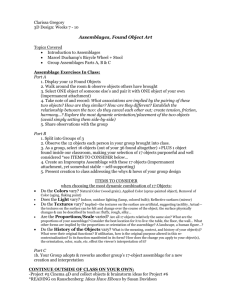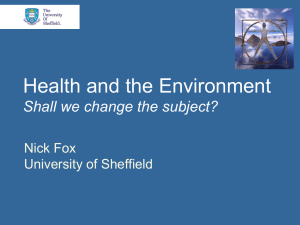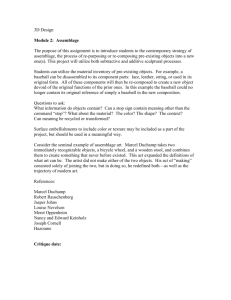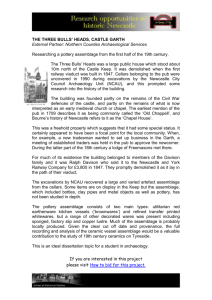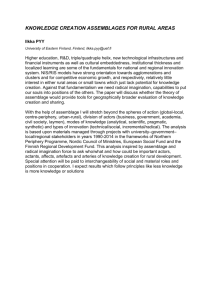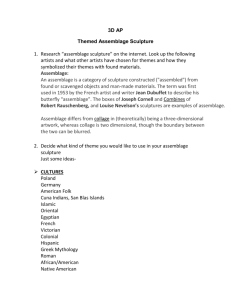Rethinking rural responses to globalization
advertisement
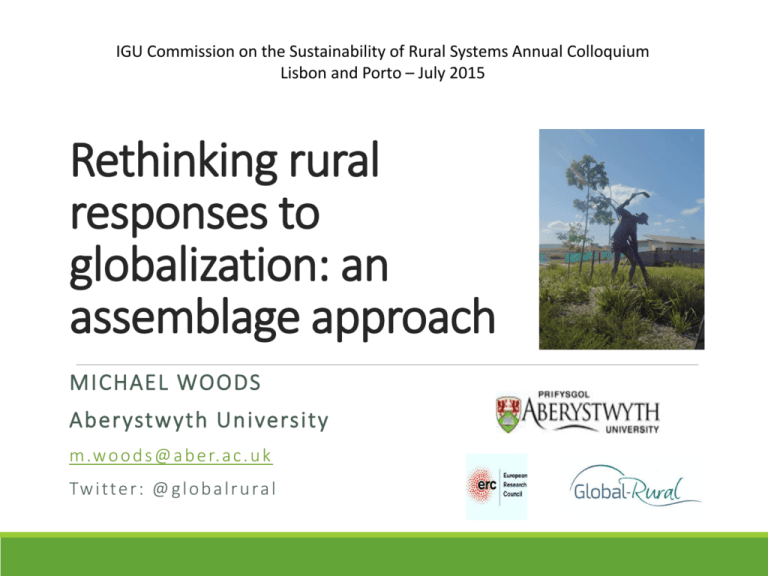
IGU Commission on the Sustainability of Rural Systems Annual Colloquium Lisbon and Porto – July 2015 Rethinking rural responses to globalization: an assemblage approach MICHAEL WOODS Aberystwyth University m .w o o d s @ a b e r. a c . u k Tw i tt e r : @ g l o b a l r u ra l Globalization is not a steamroller Relational theories of globalization “Globalization is not a single all-embracing movement (nor should it be imagined as some outward spread from the West and other centres of economic power across a passive surface of ‘space’). It is a making of space(s), an active reconfiguration and meeting-up through practices and relations of a multitude of trajectories, and it is there that lies the politics.” Massey (2005), For Space, p 83 Relational theories of globalization “In a relational understanding of neoliberal globalisation ‘places’ are criss-crossings in the wider power-geometries that constitute both themselves and ‘the global’. On this view local places are not simply always the victims of the global; nor are they always politically defensible redoubts against the global. Understanding space as the constant open production of topologies of power points to the fact that different ‘places’ will stand in contrasting relations to the global.” Massey (2005), For Space, p 101 The global countryside “Globalization processes introduce into rural localities new networks of global interconnectivity, which become threaded through and entangled with existing local assemblages, sometimes acting in concert and sometimes pulling local actants in conflicting directions. Through these entanglements, intersections and entrapments, the experience of globalization changes rural places, but it never eradicates the local. Rather, the networks, flows and actors introduced by globalization processes fuse and combine with extant local entities to produce new hybrid formations. In this way, places in the emergent global countryside retain their local distinctiveness, but they are also different to how they were before.” Woods (2007), in Progress in Human Geography, pp 499-500 Catalysts Regional Contexts and Capacities Globalization impacts Policies and Grassroots Initiatives Global Processes Regional Responses and Outcomes Regional Learning An interpretative model of globalization effects on place, from the DERREG project (www.derreg.eu) Assemblage approach • Assemblage ‘theory’ has gained popularity in Anglophone human geography as a framework for researching social structures and systems • Divergent body of ideas drawing variously on Michel Foucault, Bruno Latour and Gilles Deleuze and Felix Guattari “The term is often used to emphasise emergence, multiplicity and indeterminacy, and connects to a wider redefinition of the socio-spatial in terms of the composition of diverse elements into some form of provisional socio-spatial formation” Anderson and McFarlane (2011) in Area, p 124 Assemblage approach DeLanda’s Assemblage Theory DeLanda posits 5 core attributes of assemblages: 1) Assemblages are composed of both material and expressive components, and individual components may have both material and expressive roles 2) An assemblage is stabilized and destabilized through processes of territorialization and deterritorialization. 3) An assemblage is given an identity through coding, including practices of naming, classification and rule-setting. Decoding processes dissent from established meanings, break rules and give rise of heterogeneity. DeLanda’s Assemblage Theory 4) Assemblages are dynamic, contingent and engaged in recurrent interactions with other assemblages, from which larger assemblages have the possibility to emerge. 5) Assemblages are defined by their relations of exteriority; they can be broken down in components which may themselves be assemblages, and relations between components can be modified without changing the nature of the component itself. “a component part of an assemblage may be detached from it and plugged into a different assemblage in which its interactions are different” DeLanda (2006) A New Philosophy of Society, p. 10. Assemblage and Globalization • Globalization as a process of assembling and re-assembling components (agencement) • Transfer of components between assemblages • Recoding of assemblages and their components • Transnational networks, structures and systems as global assemblages • Created through interaction of smaller assemblages • Components may be opened up as assemblages themselves • Tendency towards internal homogeneity Assemblage and Globalization • Places are also assemblages • The transformation of places through globalization involves interaction between a place-assemblage and the translocal assemblages with which it shares components (e.g. a factory) • Globalization is reproduced through places by attaching, discarding, re-arranging and re-coding components of translocal assemblages that are also part of place-assemblages, such that one cannot change without affecting the other • Space for local agency as actors respond to globalization by seeking to re-arrange components into new assemblages that benefit the social and economic interests of the locality Closure of Moreton Sugar Mill, Nambour, QLD, 2003 “With poor harvests, falling world prices and growing competition from Brazil, the owners of the mill at Nambour – Bundaberg Sugar – say the Sunshine Coast operation is no longer viable.” ABC 7.30 Report, 15 July 2003 Norrland Sweden Newfoundland West of Ireland Wales Hebei and Shandong provinces South of Spain Tanzania Rio Grande do Sul Queensland Hawkes Bay GLOBAL-RURAL project European Research Council Advanced Grant 2014-2019 @globalrural www.globarlruralproject.wordpress.com Moreton Mill sugar assemblage • Cane-land • Cane plants • Cutters and cutting equipment • Cane trains • Mill • Milling equipment • Mill labour • Raw crushed sugar • Waste and by-products Australian sugar assemblage • Highly regulated industry with distinctive territorialisation • Monopoly structure in which Queensland Sugar acquires nearly all raw sugar when crushed and acts as a single-desk exporter • Supply controlled through system of assignments, with cane-land assigned to a particular mill with production quota • Segmented spatial territorialisation with little competition between mills Both figures from Hoyle (1980) Global sugar assemblage Components: Cane, beet, raw sugar, refined sugar, mills, refineries, storage, transport, packaging, consumer products, labour, consumers, capital, corporations, regulatory institutions, etc. Territorialization: Commodity chains connecting production and consumption, shaped by regulatory structures and agreements Globalization and the Mill Closure • Restructuring of the global sugar industry • Collapse of old supply relations, re-territorialisation towards Asian markets and increased supply to global markets from Brazil • Re-coding of sugar prices on the world market • Rigid territorialisation of Australian sugar industry, limiting opportunities for competition and efficiency savings • Characteristics of material components in the Moreton Mill assemblage > increasing profitability only by increasing assigned land • Competition for land with other local assemblages – residential development and tourism • Re-coding of mill within corporate assemblages as sold from one transnational corporation to another Response to the mill closure • Components that made up the Moreton Mill assemblage remained in situ • Closure of the mill had detached these components from the Australian sugar assemblage, and thus cut access to markets • Without a market, the material role of these components had been lost – they no longer functioned to produce sugar • Material role in the place-assemblage of Nambour also changed – no longer functioned to provide employment and generate income Sugar and the Nambour assemblage 1970s: 2,300 people employed by sugar industry at peak season and AUS$4m generated for local economy “The economy of Nambour presents a fairly diversified picture but with a heavy dependence on the sugar industry” (Field Study of Nambour and District 1971) Viability Report 1989: 550 direct jobs, 1100-3300 indirect jobs, direct value of production of up to $25 million p.a. “Agriculture has been our life. It’s what has been the strength and wealth of Nambour over the years and to lose it like this is very, very sad …. The supermarkets, the car dealers, the lawn mower people, will all have a wash off of it, so we’ll all feel it” (President of the Chamber of Commerce on the mill closure) Reassemblage Initial responses focused on keeping the local sugar assemblage together by attaching it to another larger assemblage with access to markets. 1. Detach the mill from its corporate assemblage o Farmers formed co-operative to try to buy the mill and run it themselves o Bundaberg Sugar refused to sell the site to them 2. Attach to another sugar mill’s assemblage ◦ Some cane transported to Maryborough (150km north) ◦ Sugar cane needs to be processed within 16 hours of being cut and is bulky and expensive to transport ◦ Only economically viable for growers in north of Moreton district on bitumen roads ◦ 10 cane-growers in Nambour district supplying Maryborough 2014 Reassemblage 3. Attach to the global ethanol assemblage ◦ Same initial stages as for edible sugar, enabling several components to retain same material role ◦ Introduction of new components (processing plant, capital) ◦ New exterior relations ◦ Markets conditions not in line with coding by proposers ◦ Australian government failed to deliver measures to stimulate an ethanol market that would have created a stable assemblage for the producers to connect to Reassemblage 4. ◦ ◦ ◦ ◦ ◦ Construct a new assemblage with a new product for new markets Locally developed process to turn cane into stockfeed for cattle, marketed as ‘cow candy’ Used some machinery from Moreton Mill but not site Capital investment required for new plant – government funding replaced by Chinese investment Extended territorialisation with direct links to buyers in Japan and South Korea Expectations of generating AU$90 million a year from exports, processing 300,000 tonnes of sugarcane a year, and generating at least 18 jobs Reassemblage By 2012, Biocane had gone into administration, the plant had closed and the assemblage had collapsed ◦ Dissidence of non-human components not behaving as they had been coded ◦ Spontaneous combustion of charring materials caused a fire at the plant that halted production for months ◦ Yield of sugarcane reduced by two unusually wet seasons Reassemblage • Dismantling the sugar assemblage and attaching components to alternative assemblages • Converting cane land to new uses • Land suitability study undertaken to identify alternative agricultural uses = recoding land “For most Nambour growers there was very little else they could grow but cane, as tree crops such as macademias take 14 years to begin to pay their way and small crops such as tomatoes, beans, corns and capiscums are already oversupplied much of the year … Even ploughing out the cane and turning the land over to grazing was not viewed as a desirable alternative by the local council and starting a large feedlot sourcing silage from ex-cane farms was evidently out of the question.” (Australian Sugar Yearbook 2004, p 18) Reassemblage • Preferred option would have been to sell land for housing development • Blocked by zoning laws introduced in 1980s to protect cane supply for the mill • Reaffirmed by South East Queensland Regional Plan 2004 in response to concerns about urbanization and the loss of green space • Limited exceptions Expressive roles • If material functions of components proved difficult to replace, their expressive roles proved to be surprisingly resilient • Mill, sugar and trains also played expressive roles significant to the identity of Nambour “The dark plume hanging over the town was not the only smoke in the air as bush fires were raging all around the district, but the mill stack was pumping out carbon, oblivious to the housewives’ cries of frustration at having their washing blackened. It was all in a good cause, they were told. The ash from the stack, and the heavy sweet smell of molasses, were the symbols of prosperity not just for the farmers, but for the whole town.” (Richardson 2013, in Sunshine Coast Daily, 26/10/13). The Last Hurrah Nambour by James Fearnley (Nambour Library) “Whatever happens to the cane farms, Nambour and the Sunshine Coast will never be the same again” ABC 7.30 Report, 15/07/03 Waiting for a new heritage rail tourism assemblage? Conclusions • Rural areas are not the inevitable, helpless victims of globalization • Depends on the local response to globalization impacts • Social capital, institutional capacities etc important in explaining differential outcomes between places, but an assemblage approach encourages us to look beyond the social • Assemblage approaches reveal the micro-processes and practices through which globalization is reproduced • Responses to globalization involve re-assembling components in new ways, potentially with material and/or expressive roles • Material functions and expressive functions can become detached, and expressive roles can outlive material roles • Successful responses require incorporation of new components, new external relations and attachments, and appropriate coding of components

